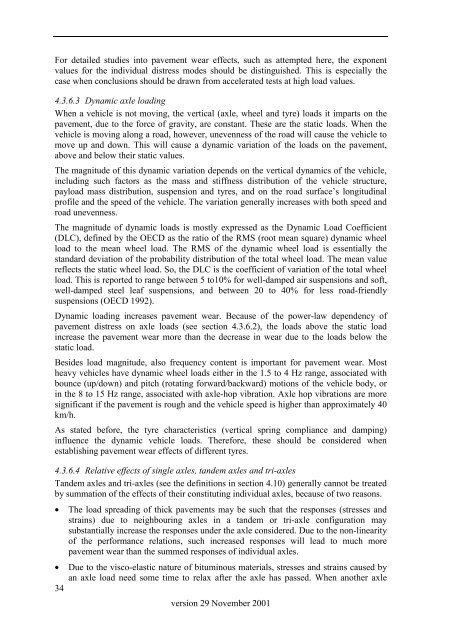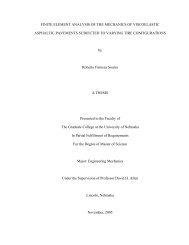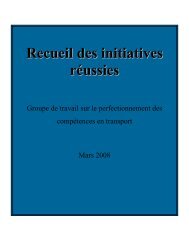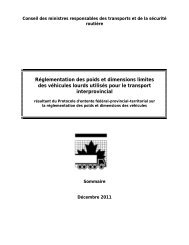You also want an ePaper? Increase the reach of your titles
YUMPU automatically turns print PDFs into web optimized ePapers that Google loves.
For detailed studies into pavement wear effects, such as attempted here, the exponentvalues for the individual distress modes should be distinguished. This is especially thecase when conclusions should be drawn from accelerated tests at high load values.4.3.6.3 Dynamic axle loadingWhen a vehicle is not moving, the vertical (axle, wheel and tyre) loads it imparts on thepavement, due to the force of gravity, are constant. These are the static loads. When thevehicle is moving along a road, however, unevenness of the road will cause the vehicle tomove up and down. This will cause a dynamic variation of the loads on the pavement,above and below their static values.The magnitude of this dynamic variation depends on the vertical dynamics of the vehicle,including such factors as the mass and stiffness distribution of the vehicle structure,payload mass distribution, suspension and tyres, and on the road surface’s longitudinalprofile and the speed of the vehicle. The variation generally increases with both speed androad unevenness.The magnitude of dynamic loads is mostly expressed as the Dynamic Load Coefficient(DLC), defined by the OECD as the ratio of the RMS (root mean square) dynamic wheelload to the mean wheel load. The RMS of the dynamic wheel load is essentially thestandard deviation of the probability distribution of the total wheel load. The mean valuereflects the static wheel load. So, the DLC is the coefficient of variation of the total wheelload. This is reported to range between 5 to10% for well-damped air suspensions and soft,well-damped steel leaf suspensions, and between 20 to 40% for less road-friendlysuspensions (OECD 1992).Dynamic loading increases pavement wear. Because of the power-law dependency ofpavement distress on axle loads (see section 4.3.6.2), the loads above the static loadincrease the pavement wear more than the decrease in wear due to the loads below thestatic load.Besides load magnitude, also frequency content is important for pavement wear. Mostheavy vehicles have dynamic wheel loads either in the 1.5 to 4 Hz range, associated withbounce (up/down) and pitch (rotating forward/backward) motions of the vehicle body, orin the 8 to 15 Hz range, associated with axle-hop vibration. Axle hop vibrations are moresignificant if the pavement is rough and the vehicle speed is higher than approximately 40km/h.As stated before, the tyre characteristics (vertical spring compliance and damping)influence the dynamic vehicle loads. Therefore, these should be considered whenestablishing pavement wear effects of different tyres.4.3.6.4 Relative effects of single axles, tandem axles and tri-axlesTandem axles and tri-axles (see the definitions in section 4.10) generally cannot be treatedby summation of the effects of their constituting individual axles, because of two reasons.• The load spreading of thick pavements may be such that the responses (stresses andstrains) due to neighbouring axles in a tandem or tri-axle configuration maysubstantially increase the responses under the axle considered. Due to the non-linearityof the performance relations, such increased responses will lead to much morepavement wear than the summed responses of individual axles.• Due to the visco-elastic nature of bituminous materials, stresses and strains caused byan axle load need some time to relax after the axle has passed. When another axle34version 29 November 2001






